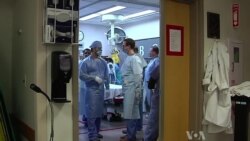BOSTON, MASSACHUSETTS —
The Boston Marathon bombings killed three and injured more than 170. But many analysts are saying the number of fatalities could have been much worse if the bombings had occurred in a different city. Boston's top-notch hospitals and pre-planning are credited with saving lives.
When bomb victims were wheeled into the Tufts Medical Center Emergency Department, the medical personnel was in place, ready for them.
"We already had our emergency management team up and running before the bombs ever went off," said Dr. Brien Barnewolt, the chief of emergency medicine. Tufts is ready for Marathon Monday every year.
Tufts is world famous. It's certified to handle the most severe injuries. Its Level 1 pediatric and adult trauma center is a two-minute drive from the bomb site. In fact, six top-notch hospitals that admitted bomb patients are within a 3.5-kilometer radius of the Marathon finish line. And, when it comes to trauma, time saves lives.
"The fact we had hospitals here that we could distribute patients to areas of expertise and do definitive care and stabilizing care right away certainly saved lives. No question about that. And I'm sure it saved limbs as well," explained Dr. Barnewolt.
And here's another reason. Many Boston hospitals have training areas that replicate trauma scenarios.
Tufts University School of Medicine has a clinical skills and simulation center where medical students and hospital trauma teams get trained. VOA is the first TV station permitted inside since its opening four years ago.
For practice, the patient is a remote-controlled mannequin who blinks and cries. The team has to figure out what's wrong and treat him. The instructors are watching from behind a two-way mirror, which allows them grade the team.
"We train and when we think we have everything nailed down, we train again," explained Dr. Horacio Hojman.
Dr. Hojman says that increases efficiency. "When we receive patients, everything works like clockwork. Nobody has to talk. We don't have to talk," he explained.
The team knows where they need to stand. They know what the next movement is, and that really helps the patients, as it did on Monday night. A show of hands indicated that the entire team was working in the emergency department.
"It was tough to get your mind around," recalled a trauma team member. "But in situations like this, we just all get to work.”
The simulation program doesn't include a scenario for bomb injuries. After this week, it may have to add one.
When bomb victims were wheeled into the Tufts Medical Center Emergency Department, the medical personnel was in place, ready for them.
"We already had our emergency management team up and running before the bombs ever went off," said Dr. Brien Barnewolt, the chief of emergency medicine. Tufts is ready for Marathon Monday every year.
Tufts is world famous. It's certified to handle the most severe injuries. Its Level 1 pediatric and adult trauma center is a two-minute drive from the bomb site. In fact, six top-notch hospitals that admitted bomb patients are within a 3.5-kilometer radius of the Marathon finish line. And, when it comes to trauma, time saves lives.
"The fact we had hospitals here that we could distribute patients to areas of expertise and do definitive care and stabilizing care right away certainly saved lives. No question about that. And I'm sure it saved limbs as well," explained Dr. Barnewolt.
And here's another reason. Many Boston hospitals have training areas that replicate trauma scenarios.
Tufts University School of Medicine has a clinical skills and simulation center where medical students and hospital trauma teams get trained. VOA is the first TV station permitted inside since its opening four years ago.
For practice, the patient is a remote-controlled mannequin who blinks and cries. The team has to figure out what's wrong and treat him. The instructors are watching from behind a two-way mirror, which allows them grade the team.
"We train and when we think we have everything nailed down, we train again," explained Dr. Horacio Hojman.
Dr. Hojman says that increases efficiency. "When we receive patients, everything works like clockwork. Nobody has to talk. We don't have to talk," he explained.
The team knows where they need to stand. They know what the next movement is, and that really helps the patients, as it did on Monday night. A show of hands indicated that the entire team was working in the emergency department.
"It was tough to get your mind around," recalled a trauma team member. "But in situations like this, we just all get to work.”
The simulation program doesn't include a scenario for bomb injuries. After this week, it may have to add one.










